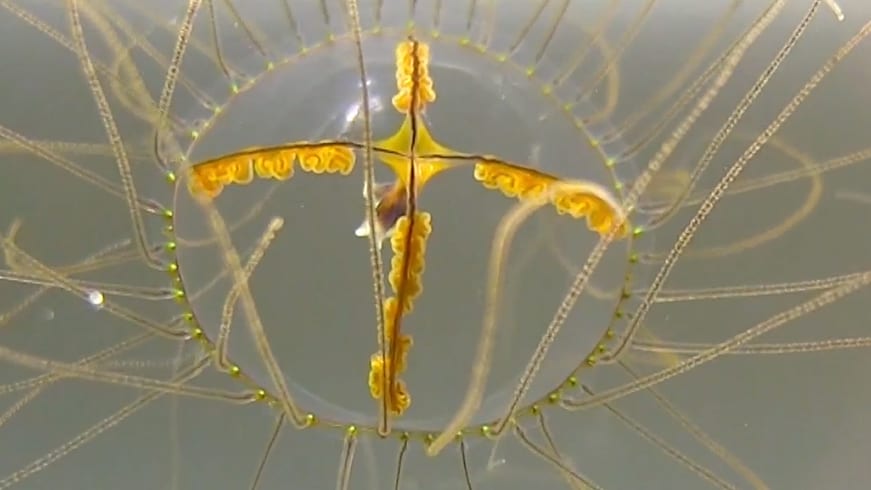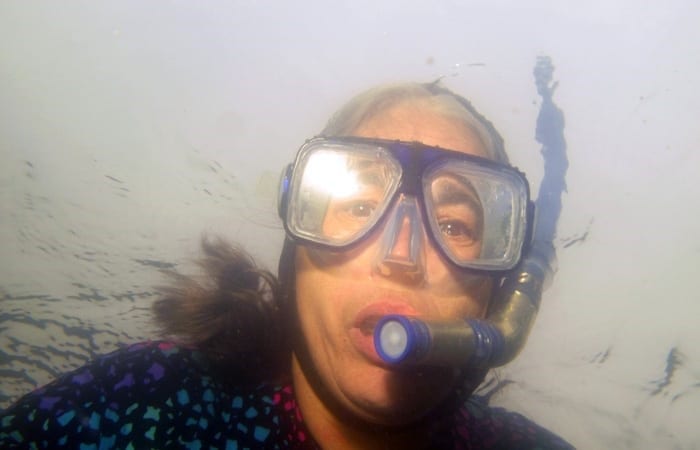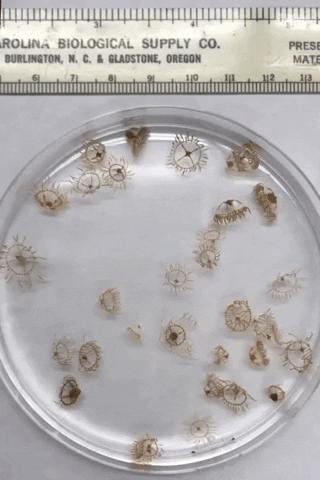Scientists investigate global spread of stinging jellyfish
Transportation and warmer ocean temperatures could play a role
By Evan Lubofsky | May 22, 2019
A clinging jellyfish spreads its tentacles as it drifts downwards. (Video by Björn Källström, Gothenburg Marine Biological Laboratory)

“Get it off of me! Get it off of me!” shrieked Mary Carman, a marine ecologist at Woods Hole Oceanographic Institution (WHOI) as she flailed knee deep in the bath-like water of Farm Pond on Martha’s Vineyard. She was observing tunicates (also known as sea squirts) in the quiet coastal pond, garbed in a full wetsuit and snorkeling gear as she hovered through the shallow grassy water. She was well covered except for parts of her face, including her lips which became a landing spot for a clinging, stinging jelly.
“The sting was one of the most painful things I’ve experienced in my life—I liken it to being injected by five hypodermic needles simultaneously,” she said.
Despite the ensuing pain and “two days of nausea,” Carman has been back in Farm Pond on several occasions. But instead of looking at tunicates, she’s been collecting samples of the toxic jellies, scientifically known as Gonionemus sp. In the past several years, she, along with WHOI biologist Annette Govindarajan and their colleagues, has been tracking these clinging jellyfish which, according to a new study, appear to be expanding throughout the Cape and Islands region.

“In recent years, we’ve started to see these jellies show up in a number of major coastal ponds across the island in addition to Farm Pond,” said Carman, the lead author of the study. “Confirmed locations have included Sengekontacket Pond, Stonewall Pond, and Lake Tashmoo,” said Carman, the lead author of the study. “Now, we’re seeing a new invasion in Edgartown Great Pond, the largest great pond on the island’s south shore.”
Secret hitchhikers
The toxic invader looks like a clear, medium-sized coat button collared with several dozen threadlike tentacles. The tentacles sport adhesive-like pads that allow the animal to stick to eelgrass, seaweeds—and yes, lips too—before emitting venomous neurotoxins that can cause extreme pain, breathing difficulties, and blisters. Their origin is unclear. The jellyfish were abundant in a few New England locations, including Eel Pond in Woods Hole, Mass. in the late 1800s until about 1930, when they all but disappeared after a slime mold decimated most of the region’s eelgrass. Carman and Govindarajan are unaware of any regional reports of stings during this period, although stings had been reported from the Sea of Japan.

Several young clinging jellyfish collected from Martha’s Vineyard swim in a petri dish. (Video by Annette Govindarajan, Woods Hole Oceanographic Institution )
The jellies resurged on Cape Cod in the 1990s, with the first documented sting report occurring in 1990 in Waquoit Bay. The first documented Martha’s Vineyard sting occurred in 2006 and it appears that the population has been expanding there ever since. According to the study, in one of the newly colonized sites (Edgartown Great Pond), jellyfish were clustered in a cove with a public boat ramp, suggesting that transport on boat hulls could be promoting their distribution around the island. “The jellyfish have life cycle stages that can be less than a millimeter in size and that adhere to surfaces, so they could very easily be hitchhiking on boats without being seen,” said Govindarajan.
The study points to another factor possibly contributing to the spread: cloning. This particular species is known to have the ability to make multiple copies of itself during various stages of asexual reproduction. “As we analyzed the sex ratio of our samples, we discovered that all of the jellies collected at Edgartown Great Pond were male,” said Govindarajan. “This is consistent with the possibility that this particular population is clonal, and that asexual reproduction is contributing to their spread. But we need more information on the dynamics of these stages, such as how long they can persist and what factors trigger them to produce jellyfish.”
Across the pond
According to the researchers, the toxic jelly outbreak isn’t just a local phenomenon: the animals have been found along the coasts of Russia, Japan, China, the Mediterranean, Argentina, and most recently, along Sweden’s rocky west coast, where just last summer, a number of bathers were stung. That outbreak was documented in another study in which Govindarajan and colleagues from Sweden compared DNA sequences of clinging jellies collected at the site with those found along the US East Coast and other parts of the world, and discovered some genetic similarities.
“We found some common genetic variants occurring in disparate locations where stings have been reported,” said Govindarajan. “We’re not sure what’s triggering these toxic outbreaks – multiple factors may be at play, but human-mediated transport of the tiny, cryptic life stages may have a role globally as well as locally.”
Björn Källström, a marine biologist at Gothenburg Marine Biological Laboratory and co-author of the study, says underwater photographers have observed clinging jellies in Sweden in the past, but last summer marked the first time that people there reported being stung.
“One factor may have been the really hot and dry summer we had last year, which caused water temperatures at the site to surge 3°C above seasonal averages,” he said. “Previous studies have suggested that when ocean temperatures are warmer, clinging jellyfish production is triggered. And when they increase in numbers, more people are likely to encounter and get stung by them.”
Avoiding hot spots
With a host of possible factors at play—anthropogenic transport, warmer ocean temperatures, and the comeback of eelgrass—Govindarajan, Carman, and their international colleagues plan to continue studying the stinging creatures to better understand the intricacies of the spread.
Källström feels that in the near term, the research can help bathers avoid areas where the jellies are likely to disperse.
“Climatologist have predicted another hot, dry summer in Sweden, which means that we could see another outbreak over the next few months,” he said. “And this time, we suspect it may spread to other locations along the coast. So, we’ll be developing models to help predict where the jellies may go, so people know which areas to stay away from.”
Govindarajan agrees. “The more we can learn about how they’re expanding and the types of conditions the jellies are thriving in, the more we’ll be able to identify where the hot spots are and educate the public.”
Gonvindarajan says the community can also help the monitoring effort by reporting sightings of clinging jellies to jellyfish@whoi.edu—although she cautions people to be careful, and to not handle the jellies.
Funding for the Martha’s Vineyard study was funded by the Community Preservation Committee of Oak Bluffs, Massachusetts; Oak Bluffs Shellfish Department; Great Pond Foundation; Edey Foundation; USGS-WHOI Cooperative Program. Funding for the Sweden study Funding was provided by the Swedish Research Council (VR) to Erik Selander “Signals in the Sea” and from the Faculty of Science of Uppsala University to Carina Östman. Funding for the DNA sequencing analysis was provided by the Kathleen M. and Peter E. Naktenis Family Foundation and the Borrego Foundation.
